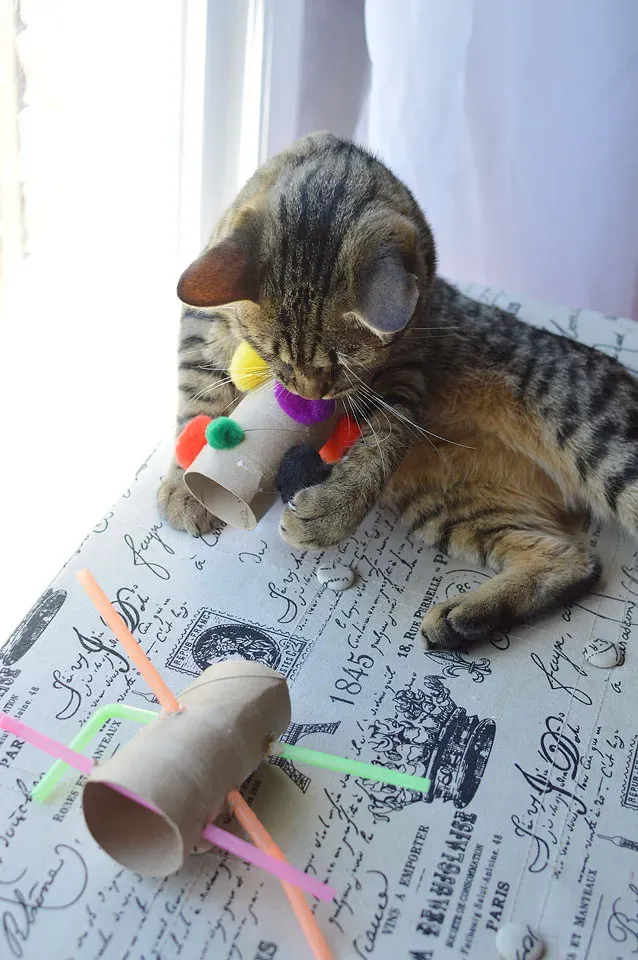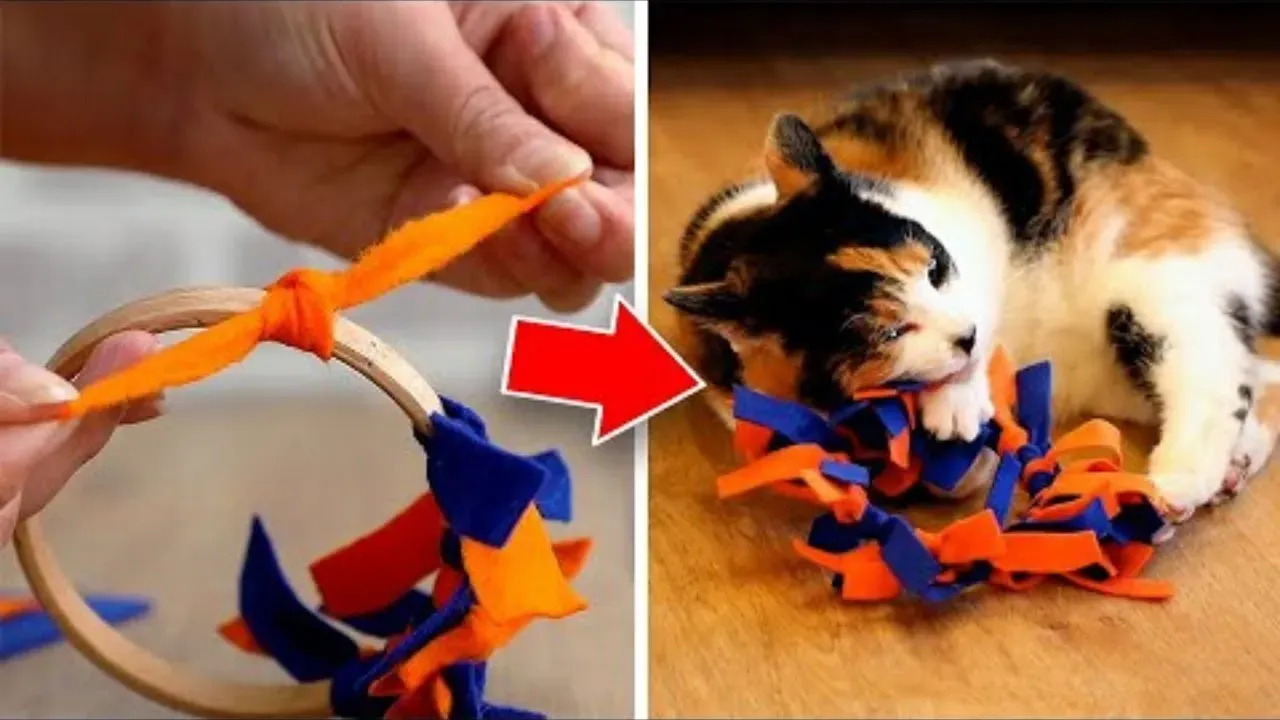Table of Contents
Let's be honest, you've likely dropped good money on cat toys only to watch your feline companion play with the box instead. It's a classic cat owner rite of passage. Those expensive, fancy contraptions often gather dust while a crumpled receipt becomes the object of intense hunting focus. The reality is, indoor cats need stimulation, and you don't need a second mortgage to provide it.
Why Bother with Homemade Cat Toys for Indoor Cats?

Why Bother with Homemade Cat Toys for Indoor Cats?
so you might be thinking, "Isn't it easier just to buy a laser pointer and call it a day?" And yeah, sometimes it is. But let's talk about *why bother with homemade cat toys for indoor cats* beyond just saving a few bucks. First off, it's about mental stimulation. Indoor cats don't have the natural hunting grounds of their outdoor cousins. They need outlets for those instincts, and a varied selection of toys keeps their brains engaged. Ever watch a cat stalk a dust bunny? That's instinct in action. Plus, it's a fantastic way to bond with your cat. When you create something they love, you're not just giving them a toy; you're giving them a piece of your time and effort, and they totally pick up on that. It's also a brilliant way to repurpose stuff you'd otherwise toss, which feels pretty good in a world overflowing with plastic junk.
Seriously Simple Homemade Cat Toys from Household Stuff

Seriously Simple Homemade Cat Toys from Household Stuff
Alright, let's dive into the glorious world of *Seriously Simple Homemade Cat Toys from Household Stuff*. Forget fancy pet store aisles for a minute. Look around your house. You're likely sitting on a goldmine of potential feline entertainment, masquerading as trash or recycling. Think toilet paper rolls, empty boxes, crumpled paper, bottle caps (the plastic kind, safety first!), or even just a loose string (supervised play only, obviously). These aren't just filler ideas; a surprising number of cats will choose a discarded cardboard tube over a plush mouse filled with grade-A catnip any day. It taps into their natural curiosity and hunting drive without costing you a dime. My own cat, a creature of exquisite taste and questionable judgment, once spent an hour batting a single, rogue dry pasta shell across the floor. It was riveting. For him, anyway.
- The Mighty Cardboard Tube: A simple toilet paper or paper towel roll. Cats love batting them, chasing them, or even trying to wear them like tiny hats (results may vary).
- Crumpled Paper Ball: Take any piece of scrap paper, crumple it tightly. The crinkle sound and erratic movement are irresistible.
- The Humble Box: Any cardboard box is a potential fort, ambush point, or napping spot. Cut some extra holes for peek-a-boo action.
- Plastic Bottle Cap: A lightweight plastic cap from a water bottle or milk jug. They slide well on hard floors and are perfect for batting practice. Ensure it's large enough not to be swallowed.
- Paper Bag Hideout: A classic. Lay a paper grocery bag on its side. Cats love hiding inside, pouncing out, and enjoying the crinkle. Cut off any handles to prevent entanglement.
Level Up: Craftier Homemade Cat Toys Your Feline Might Approve Of

Level Up: Craftier Homemade Cat Toys Your Feline Might Approve Of
Beyond the Basics: Simple Sewing and Fabric Fun
so you've mastered the crumpled paper ball and your cat has officially lost interest in the toilet paper tube you so lovingly provided. It's time to kick things up a notch, but don't panic – we're not talking about competitive crafting here. Think simple sewing or using felt. Cats often go nuts for felt because it has a different texture and you can easily infuse it with catnip. A basic shape like a fish or a mouse, sewn together with a little stuffing and maybe some dried catnip inside, can be a huge hit. You don't need a sewing machine; a simple needle and thread will do the trick. Even just cutting strips of felt and tying them together creates a fun, floppy toy. The key is creating something soft, chewable, and perhaps a little erratic in its movement.
Puzzle Play: Engaging Their Brains (and Bellies)
Another area to explore is puzzle toys. These are fantastic for indoor cats because they tap into their natural foraging instincts. You can easily make simple ones at home. A cardboard box with holes cut into it, large enough for a paw but too small for the whole head, works wonders. Drop some dry treats or kibble inside, and watch your cat work to get them out. It's mentally stimulating and rewards their effort. You can also use empty plastic bottles (ensure the cap is secure or removed) and cut holes in the sides, then put treats inside. As they bat the bottle around, treats fall out. It's simple physics meets feline motivation.
- Felt shapes (fish, mice, birds) stuffed with batting and catnip.
- Cardboard tube filled with treats, ends folded shut.
- Old sock stuffed with fabric scraps and catnip, tied securely.
- Plastic Easter eggs with small holes, filled with kibble.
- Wine cork with feathers or fabric strips glued on (use non-toxic glue).
Wand Toys: Interactive Hunting Simulations
Wand toys are probably one of the most effective types of homemade cat toys for indoor cats because they allow you to simulate hunting prey. You're controlling the movement, making it erratic, fast, and then slow, mimicking a real chase. You can use a dowel rod, a sturdy stick, or even just an old coat hanger straightened out (be careful of sharp ends!). Tie strips of fabric, feathers (ensure they are securely attached and not easily swallowed), or even crumpled paper to the end. The key is to make the "prey" at the end light and enticing. Drag it along the floor, make it dart behind furniture, pull it up into the air. This isn't just play; it's a workout and a bonding experience rolled into one.
Safety First: Making Your Homemade Cat Toys for Indoor Cats Safe and Sound

Safety First: Making Your Homemade Cat Toys for Indoor Cats Safe and Sound
Beware the Tiny Terror: Choking Hazards and Ingestion Risks
So you've crafted a masterpiece out of yarn and bottle caps. Your cat is batting it around with glee. That's great, but pause for a second. The biggest pitfall with homemade cat toys, especially for indoor cats who might not have other distractions, is the risk of them eating something they shouldn't. Cats have those barbed tongues designed to groom, which means anything they lick or chew on can easily get pulled down their throat. Think small buttons, beads, googly eyes, loose strings, or anything that can break off into tiny pieces. If you're adding embellishments, make sure they are absolutely, irrevocably secured. Better yet, skip the tiny bits altogether. A plain felt shape is far safer than one adorned with choking hazards.
Materials Matter: What NOT to Use in Your Creations
Not all household items are created equal when it comes to feline safety. Just because it's lying around doesn't mean it's toy material. Avoid anything toxic or that could splinter or cut. This includes things like twist ties (sharp ends!), elastic bands (can cause intestinal blockages if swallowed), plastic bags (suffocation risk, though paper bags are fine with handles removed), and anything painted or treated with chemicals that aren't pet-safe. When in doubt, leave it out. Your cat's health is more important than that extra bit of sparkle. And for the love of all that is holy, no human hair ties – those things are like cat candy and a trip to the vet waiting to happen.
Avoid Using | Why It's Dangerous |
|---|---|
Small Buttons, Beads, Googly Eyes | Choking hazard, potential intestinal blockage. |
Loose Strings, Yarn (unsupervised) | Can cause severe intestinal damage if swallowed. |
Elastic Bands, Hair Ties | High risk of intestinal blockage. |
Twist Ties, Wire | Sharp ends can cause injury. |
Anything with Toxic Paint or Chemicals | Ingestion can lead to poisoning. |
Supervision is Key: You're the Toy Referee
Even the most carefully constructed homemade cat toys for indoor cats require supervision, especially initially. Watch how your cat interacts with the new toy. Are they just batting it, or are they trying to chew pieces off? If they start dismantling it or trying to eat parts, it's time to take it away. Regularly inspect all homemade toys for wear and tear. Loose threads, torn fabric, or exposed stuffing are signs that the toy is past its prime and needs to be repaired or, more likely, retired. Think of yourself as the toy quality control manager. A few minutes of checking can prevent a lot of worry and potential emergency vet visits down the line. It's the responsible, albeit slightly less glamorous, part of being a DIY cat toy enthusiast.
The Final Scratch: Keeping Indoor Cats Happy on a Budget
So there you have it. You don't need to break the bank or become a master crafter to keep your indoor cat entertained. Simple items you likely already have can be transformed into enticing playthings that satisfy their natural hunting instincts. Remember, the goal is engagement, not expensive gadgets. By focusing on safety, creativity, and using resources wisely, you can provide hours of amusement for your feline companion with these *homemade cat toys for indoor cats*. Now go forth and conquer that boredom, one toilet paper roll at a time.